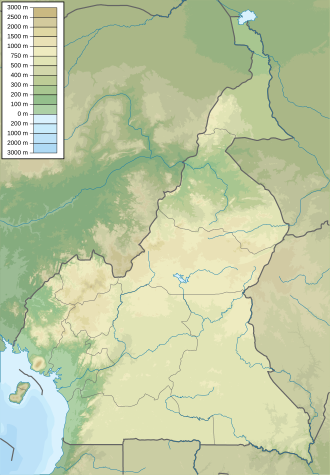Faro National Park
| Faro National Park | |
|---|---|
| Location | Cameroon |
| Coordinates | 8°10′N 12°40′E / 8.167°N 12.667°E |
| Area | 3,300 km2 |
| Governing body | Cameroon National Parks |

Faro National Park is a national park and protected area in North Province of Cameroon, close to the Nigerian border. It forms a component of a broader protected landscape in Central Africa. Established in 1989, it covers an area of 3,418 km2 (1,320 sq mi). The park is home to large mammal populations, including African elephants, African lions, cheetahs, black rhinoceros, and various hippopotamus.
History
[edit]Faro National Park was officially incorporated in 1980 by the government.[1] The park forms a component of a broader protected landscape in Central Africa, which strteches across the Nigerian border as the Gashaka Gumti National Park.[2][3]
Geography
[edit]The park covers an area of 3,418 km2 (1,320 sq mi) and lies in the Faro River basin, predominantly in the drier Sudano-Sahelian region.[2] It is located close to the Nigerian border, and there are several hunting reserves spread across the area.[2][4] The park is home to the Faro and Déo rivers, which flows into the national park area. The levels of the rivers vary across seasons, revealing sandy embankments during the drier season.[1][4] The topography of park is generally undulating, and consists of river valleys and scattered hill tops on the Savanna plains. with an average altitude of approximately 250 to 700 m (820 to 2,300 ft) above sea level.[4][5]
Biodiversity
[edit]The vegetation consists of Sudanian savanna woodlands in the south, which is intermingled with mixed grasslands in the north interspersed with dense deciduous and semi-evergreen forests.[4] The region has its own micro climate,[2] and the presence of various forest habitats allows for a wide range of species to thrive.[1] The park is home to large mammals such as cheetahs, black rhinoceros, elephants, lions, and colonies of hippopotamuses.[1][6][7] It has the largest hippopotamus population in Central and West Africa.[8]
Threats and conservation
[edit]The park faces various threats due to commercial poaching, climate change, illegal fishing, mining, and human-wildlife conflict due to cross-border livestock rearing.[2][8] Conservation organizations work with the government to ensure the needs of local communities and Indigenous people are met.[8]
See also
[edit]
References
[edit]- ^ a b c d "Faro National Park". African Wildlife Foundation. Retrieved 1 June 2025.
- ^ a b c d e "Faro landscape". Conserve Global. Retrieved 1 June 2025.
- ^ "Gashaka Gumti National Park". Nigerian National Park Service. Retrieved 1 June 2025.
- ^ a b c d "Faro National Park (Important Birds Areas of Cameroon". Birdlife International. Retrieved 1 June 2025.
- ^ "Faro National Park, Cameroon". Protected Planet. Retrieved 1 June 2025.
- ^ "Faro". Global National Parks. Retrieved 1 June 2025.
- ^ Riley, Laura; William Riley (2005). Nature's Strongholds: The World's Great Wildlife Reserves. Princeton University Press. pp. 40. ISBN 0-691-12219-9.
- ^ a b c "Faro". African Wildlife foundation. Retrieved 1 June 2025.

